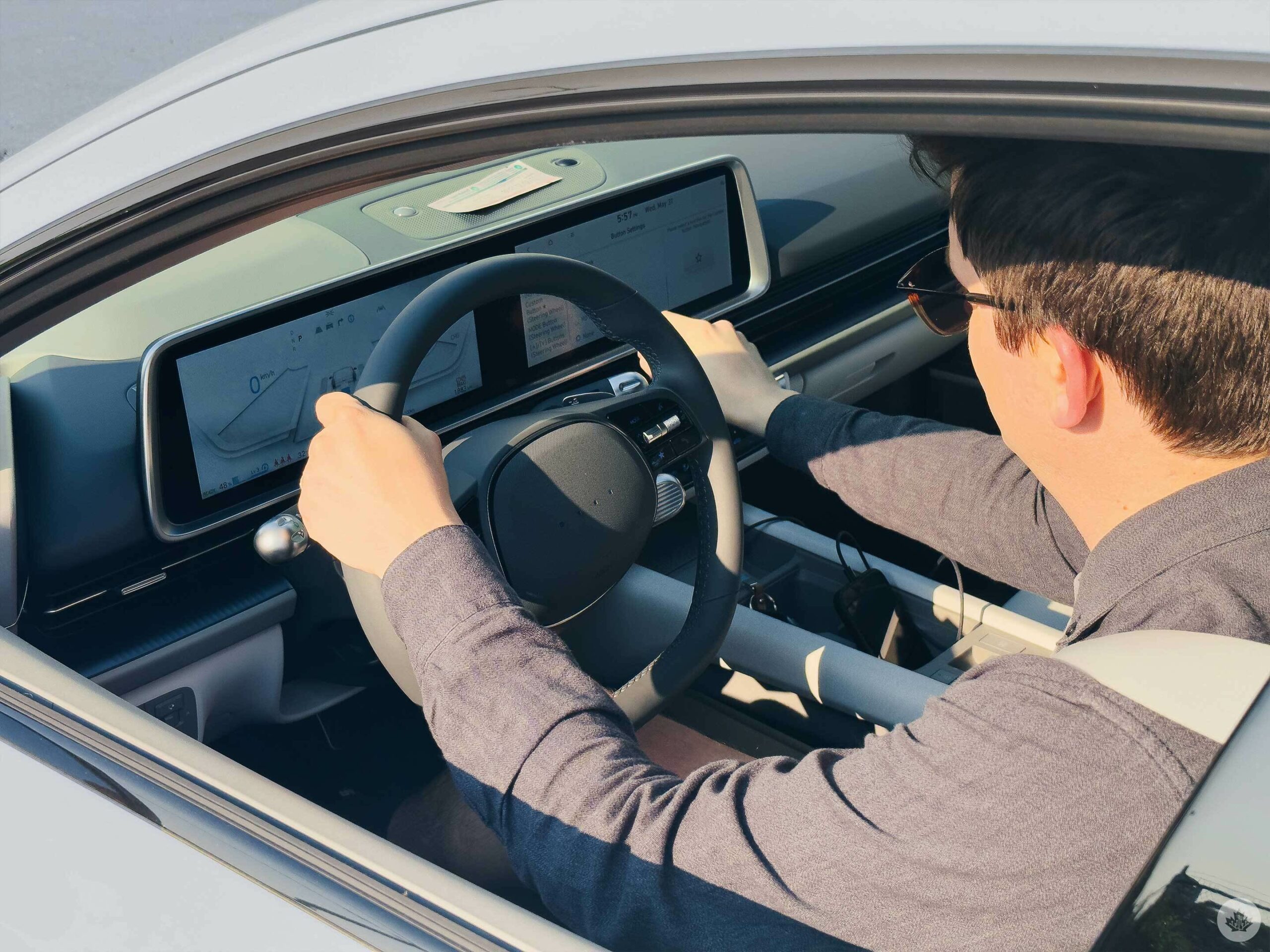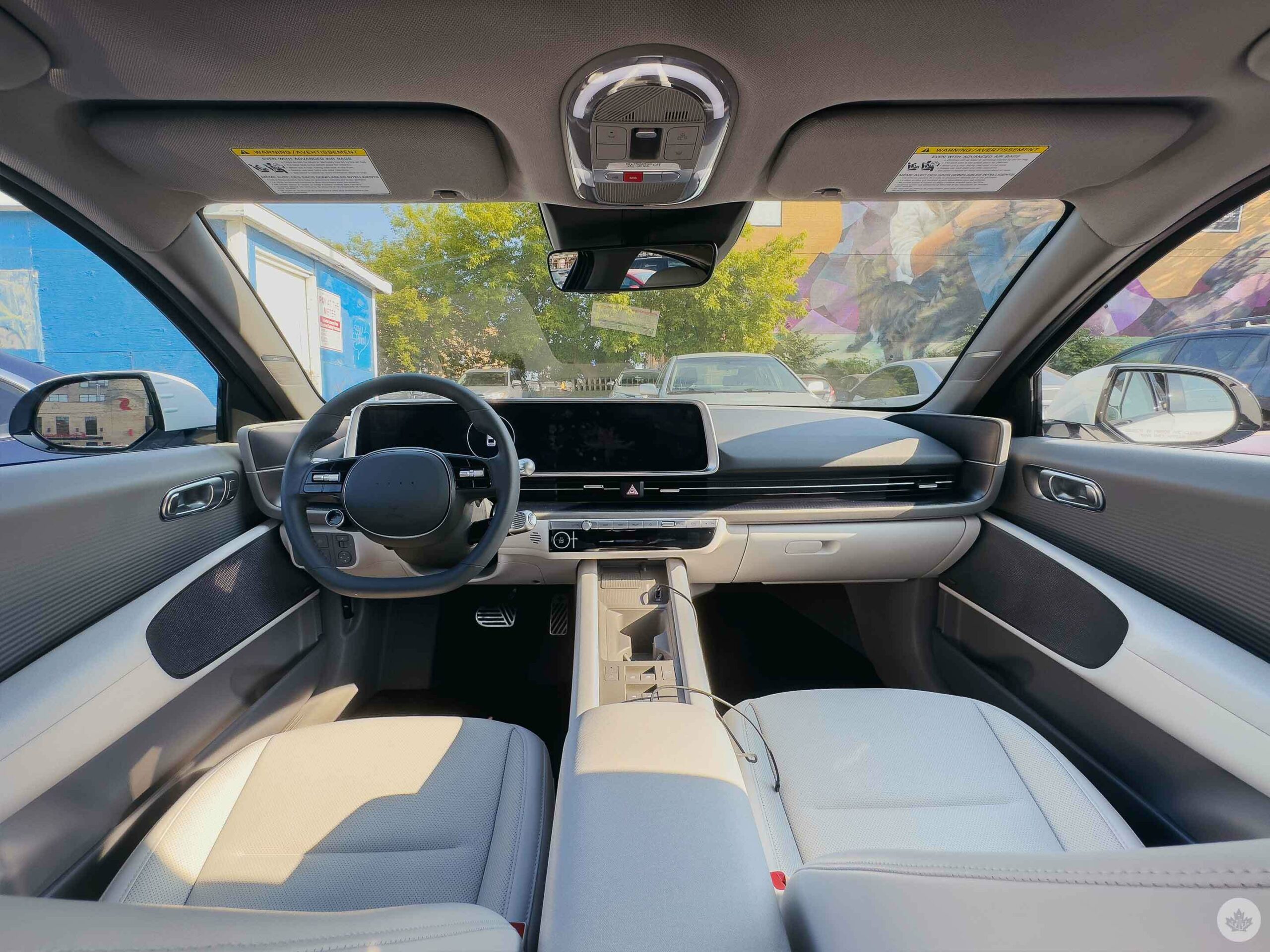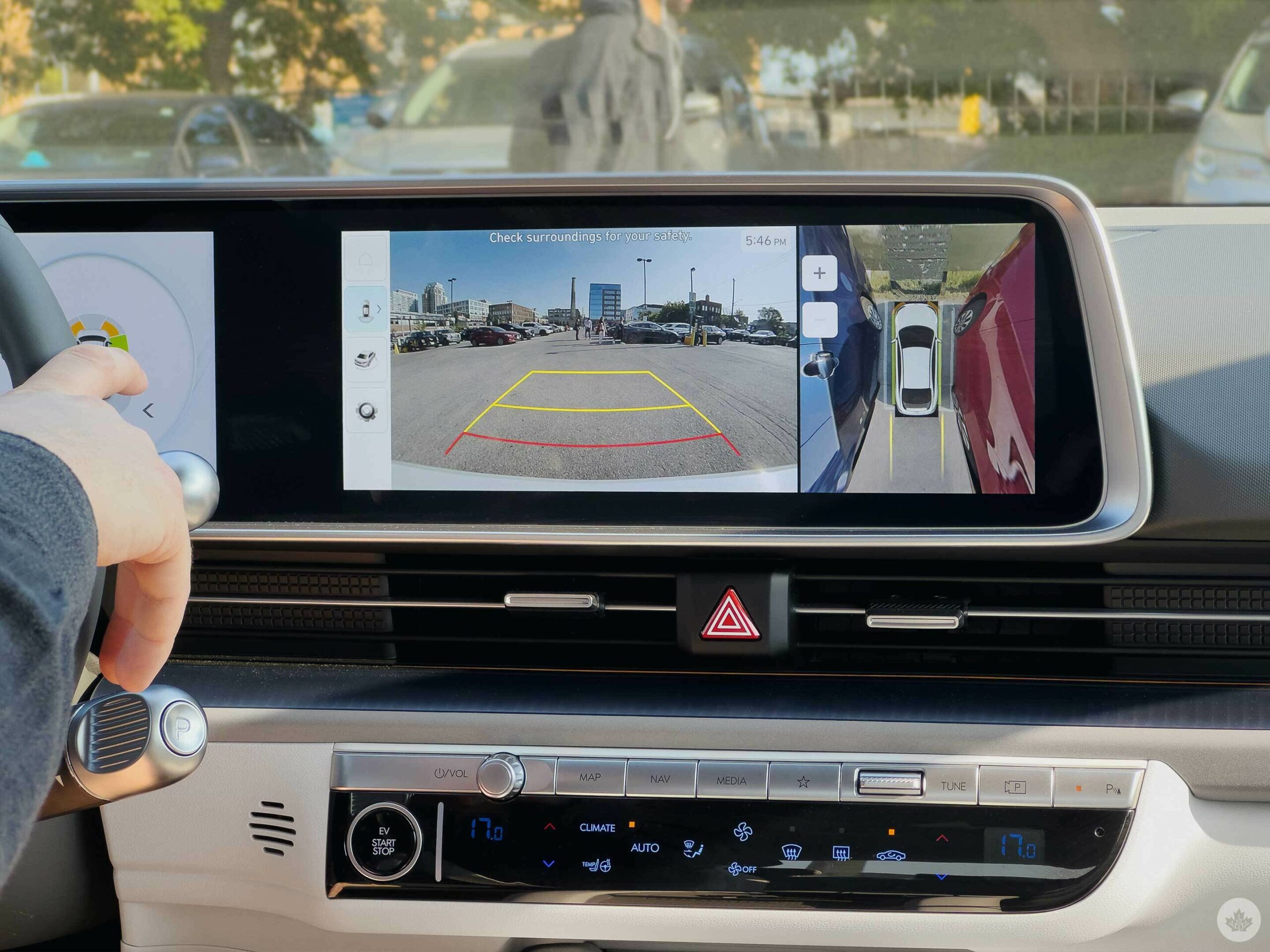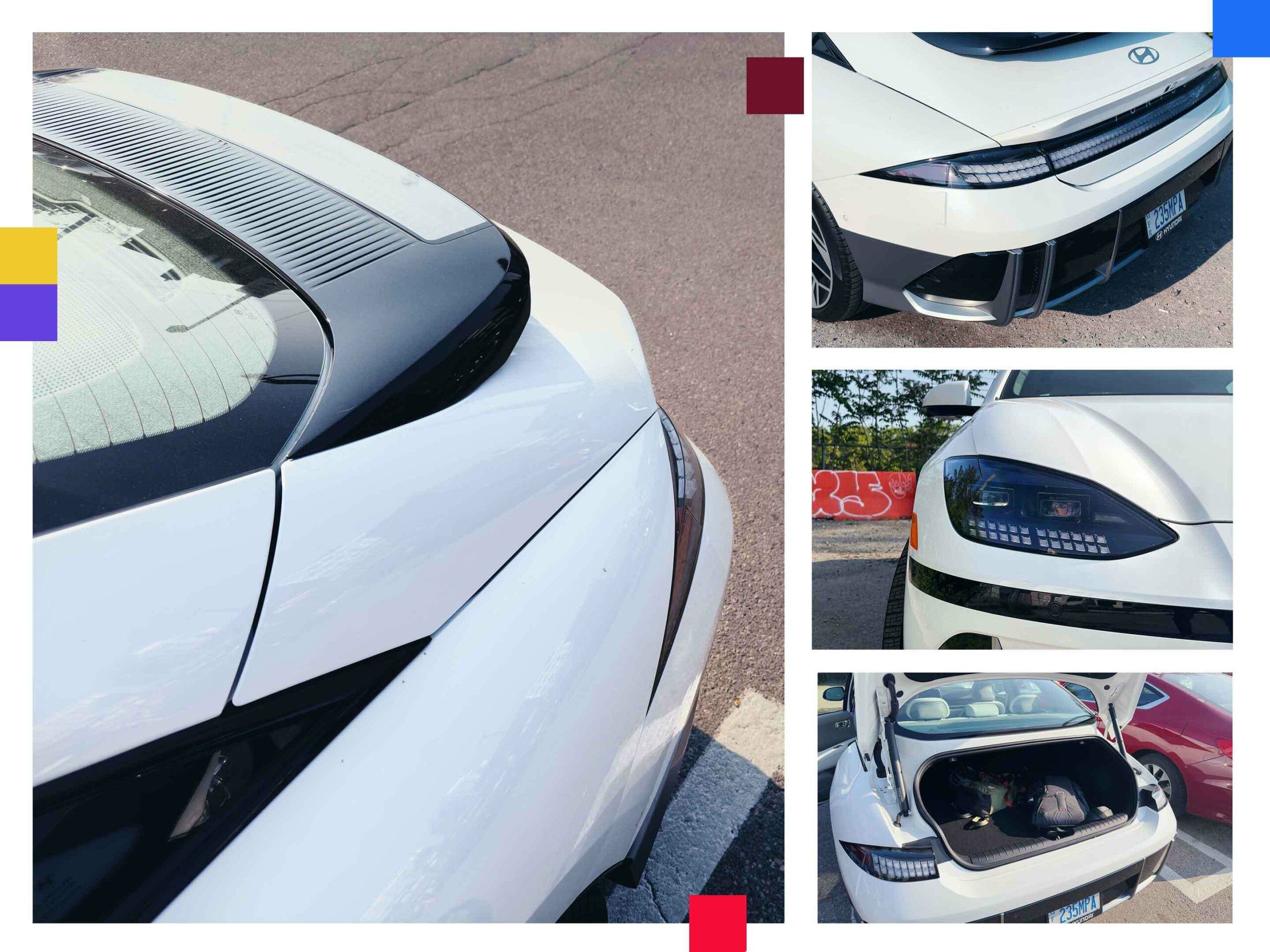
When Hyundai offered me the chance to try the Ioniq 6 for a week, I jumped at the opportunity. Despite not being a car person™, the new electric sedan piqued my curiosity since I own the Ioniq 5 and wanted to see if I’d prefer its sportier counterpart.
After just a few minutes with the Ioniq 6 its ample agility comes through, making it extremely fun to drive, but there are a few caveats that keep me leaning towards the Ioniq 5 for most people.
I expected this since the Ioniq 6 is a sedan designed for “young professionals” and not a larger, more family-oriented SUV like the Ioniq 5. However, the car’s handling is superb, and I can’t get over how easily it takes corners. Compared to the Ioniq 5, which features what I’d describe as floaty, smooth handling, Hyundai’s sedan EV is more responsive across the board. It’s a joy to drive, whether I’m stuck in traffic, cruising down an open road or even just changing lanes.
Strangely, the Ioniq 6’s acceleration is slightly delayed compared to the Ioniq 5’s. The instant torque EVs are known for is present and more powerful than Hyundai’s SUV, but the pedal response features what I’d describe as lag. It’s a minor issue, but it’s still noteworthy and unexpected, given both cars are built on Hyundai’s excellent E-GMP battery platform.
“The overall look is reminiscent of a child trying to draw a Porche from memory or a Porche someone sat on and squished a bit, but in a good way.”
Making this shortcoming even stranger, the Ioniq 6 I tested is the all-wheel drive 239kW version, while my Ioniq 5 is the less powerful standard 125kW model without AWD. There’s a possibility this could be an intentional design decision on Hyundai’s part to make the Ioniq 6’s pedal feel more like a standard gas vehicle. However, I’m not sure why anyone would want this, as that instant reaction is part of what makes driving an EV so great.
 Moving beyond handling, several subtle design changes illustrate how the South Korean carmaker is already learning from the Ioniq 5’s shortcomings. First, the Ioniq 6 features USB-C and USB-A ports, including two of the latter in the back and one USB-A port in the front to connect your phone to CarPlay or Android Auto. Since USB-C is the standard in the Android world and the iPhone is likely switching from Lightning to USB-C with the iPhone 15, this isn’t what I expected. Still, the mix of port types is a step above the Ioniq 5’s complete lack of USB-C.
Moving beyond handling, several subtle design changes illustrate how the South Korean carmaker is already learning from the Ioniq 5’s shortcomings. First, the Ioniq 6 features USB-C and USB-A ports, including two of the latter in the back and one USB-A port in the front to connect your phone to CarPlay or Android Auto. Since USB-C is the standard in the Android world and the iPhone is likely switching from Lightning to USB-C with the iPhone 15, this isn’t what I expected. Still, the mix of port types is a step above the Ioniq 5’s complete lack of USB-C.
Speaking of infotainment, during my roughly seven days with the Ioniq 6, I didn’t encounter a single disconnection while using CarPlay, a problem I continue to run into with my Ioniq 5 despite getting the USB port replaced at my local Hyundai dealer (the issue occurs less frequently, but it still happens, particularly when it’s hot inside the car).

Another subtle change the Ioniq 6 offers with certain trims is that the car remembers my seat settings. Every time I get in the driver’s seat, even after my partner drives the car, it changes to my settings as long as I have the correct profile selected. This is a great addition that a vehicle in this price range should include and something I wish the Ioniq 5 offered.
Next, there’s the design. I’m still undecided regarding how I feel about the Ioniq 6’s aesthetic. Its curved edges look stunning from certain angles, and I’m also a big fan of its rounded rear and understated taillights. The overall look is reminiscent of a child trying to draw a Porche from memory or a Porche someone sat on and squished a bit, but in a good way. I’m less into the Ioniq 6’s side profile, but from the front and back, it features a subtly unique look that makes it stand out from other sedans, especially Tesla’s Model 3.
On the other hand, Hyundai made a bold statement with the Ioniq 5’s blocky, video game-like aesthetic, and the Ioniq 6 looks far more normal in comparison. I would have preferred if the carmaker stuck with the SUV’s more inspired design for the Ioniq 6 — I’m a sucker for Nintendo 64-era visuals in the real world.
 I’m also conflicted about the interior’s look.
I’m also conflicted about the interior’s look.
While the inside of the Ioniq 6 looks and feels decidedly high-end, it’s also somewhat over-the-top and gaudy, especially at night with the interior lights on (the highest-end Ioniq 5 trim also features interior lights). This is partly because the model I tested features a ‘Grey Leatherette’ interior, which is only available with the higher-end AWD Long Range model as part of the additional $6,000 ‘Ultimate Package.’ I’ve seen the standard ‘Black Cloth’ Ioniq 6 interior on the road, and it looks far sleeker and understated than the light grey option (which is more white than grey). The car’s pair of displays are very similar to the Ioniq 5’s, only with black bezels and a silver border. I like the look of the Ioniq 6’s black bezels since it makes the displays fade more into the dashboard, but I’m also a fan of the Ioniq 5’s more iPad-like display look. The steering wheel, paddles and shifter are also all identical to the Ioniq 5’s
It’s worth noting that just like the Ioniq 5, there’s ample space inside the Ioniq 6. Whether you’re sitting in the passenger seat or driving, there’s a lot of room to stretch out (this is a far cry from the decidedly cramped Polestar 2 I recently tested), and even the trunk is sizable for a sedan. On a side note, the trunk is covered in fabric, making it more resistant to scratches. It’s a subtle touch, but as someone who moves a lot of stuff around with their Ioniq 5 and hates scuffs, I appreciate this (I’ve purchased stick-on fabric for my Ioniq 5’s trunk, but beware, applying it is a nightmare).

Speaking of price, as is typical with media cars, the model I tested out is the fully tricked-out version of the Ioniq 6. This means it features the already-mentioned interior material, AWD, Highway Driving Assist II with lane-changing, a sunroof, a heads-up display (HUD), blind spot/360 cameras and the ability to make the car drive forwards and backwards with just the key fob, costing a total of $64,689 (before any government incentives).
Most of these features are pretty frivolous, particularly the Driving Assist II lane-changing, which is incredibly slow, and the car’s keyfob driving feature for pulling forwards and backwards out of parking sports. They’re undeniably cool, but also the sort of features you try a few times and rarely use again until you want to show your car off to friends or family.
The two features I actually missed when returning to my Preferred Long Range Ioniq 5, which doesn’t include this extra functionality, are the 360 top-down and blind spot cameras. As someone who is never quite sure exactly how large their car is when parking, these two features offer a welcome piece of mind. Of course, this version of the Ioniq 5 starts at $55,652, priced under the Ioniq 6 I took for a spin (the comparable Ioniq 6 model with a similar feature set starts at $57,652).
 Finally, in my experience, both vehicles’ ranges felt roughly the same. On paper, the Ioniq 6 AWD model I tested can hit 509km, while my Ioniq 5 trim is rated for 488km. If you’ve driven an EV before, you’ll know that range can shift wildly based on the temperature outside, weather conditions, how fast you’re driving and whether you’re using self-driving features. With this in mind, I always approach manufacturer range estimates with skepticism. During my time with the Ioniq 6, range was rarely a real concern, which echoes my experience with the Ioniq 5 — and this is what really matters when it comes to driving an EV consistently.
Finally, in my experience, both vehicles’ ranges felt roughly the same. On paper, the Ioniq 6 AWD model I tested can hit 509km, while my Ioniq 5 trim is rated for 488km. If you’ve driven an EV before, you’ll know that range can shift wildly based on the temperature outside, weather conditions, how fast you’re driving and whether you’re using self-driving features. With this in mind, I always approach manufacturer range estimates with skepticism. During my time with the Ioniq 6, range was rarely a real concern, which echoes my experience with the Ioniq 5 — and this is what really matters when it comes to driving an EV consistently.
Overall, I enjoyed my week with the Ioniq 6. It’s a solid, fun electric vehicle with a great design inside and out, but I still prefer the Ioniq 5 because I like the extra cargo space it offers and appreciate its blocky design (there’s really still nothing on the road that looks like it).
For more on the Ioniq 5, check out my story about the EV where I unpack what it’s like to drive the car for 20,000km.
Photography by Bradley Bennett.
MobileSyrup may earn a commission from purchases made via our links, which helps fund the journalism we provide free on our website. These links do not influence our editorial content. Support us here.




